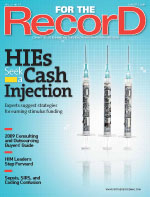 August 3, 2009
August 3, 2009
Coding for Sleep Disorders
For The Record
Vol. 21 No. 15 P. 27
Sleep disorders include any difficulties related to sleeping. There are more than 100 different sleep disorders that can be broken into four main categories: problems with falling asleep or staying asleep, problems with staying awake, problems with sticking to a regular sleep schedule, or sleep disruptive behaviors.
Problems With Falling and Staying Asleep (Insomnia)
This group of sleep disorders is more commonly termed insomnia. Besides difficulty with falling asleep and staying asleep, it also includes intermittent wakefulness and early-morning awakening. Insomnia can be transient, short term, or long lasting. Some common risk factors for insomnia include certain physical conditions such as chronic pain, increased urinary frequency, or gastroesophageal reflux disease; depression; anxiety or stress; a poor sleeping environment; caffeine; alcohol or drugs; certain medications; heavy smoking; and daytime naps.
Common insomnia disorders include the following:
• adjustment insomnia (307.41);
• psychophysiological insomnia (307.42);
• delayed sleep phase syndrome (327.31 if organic and 307.45 if of nonorganic origin);
• drug-induced sleep disorders (292.85);
• alcohol-induced sleep disorders (291.82); and
• organic insomnia (subcategory 327.0).
Insomnia unspecified is classified to code 780.52.
Problems With Staying Awake (Hypersomnia)
Some common hypersomnia disorders include the following:
• Sleep apnea, which causes intermittent breathing cessation during sleep. The ICD-9-CM code assignment will depend on the cause. Organic sleep apnea is classified to subcategory 327.2. Unspecified sleep apnea is assigned to code 780.57. Insomnia with sleep apnea, unspecified, is classified to code 780.51, and hypersomnia with sleep apnea, unspecified, goes to code 780.53.
• Narcolepsy is when the person suddenly falls asleep during the day without warning. Narcolepsy is assigned to code 347.00. If the narcolepsy is with cataplexy, assign code 347.01.
• Restless leg syndrome (333.94) is an uncomfortable limb sensation causing limb movements during sleep.
• Periodic limb movement disorder (327.51).
• Obstructive sleep apnea (327.23).
• Primary central sleep apnea (327.21). If the central sleep apnea is due to an underlying condition, assign code 327.27 as a secondary diagnosis with the underlying condition sequenced first.
• Idiopathic hypersomnia is classified to code 327.11 if it involves a long sleep time and code 327.12 if it doesn’t.
Problems With Sticking to a Regular Sleep Schedule
Some common sleep disruptions include the following:
• sleep state misperception;
• shift work sleep disorder (327.36);
• natural short sleeper (307.49);
• frequently traveling between time zones (327.35); and
• irregular sleep-wake syndrome (327.33).
Sleep-Disruptive Behaviors (Parasomnia)
Parasomnias occur more commonly in children and may include some of the following disorders:
• Sleep terror disorder (307.46) is the abrupt awakening from sleep with fear, sweating, and increased heart rate.
• Sleepwalking (307.46).
• Rapid eye movement sleep behavior disorder (327.42).
Symptoms
Symptoms may vary depending on the particular type of sleep disorder a patient experiences. Some common symptoms of sleep disorder include awakening in the night, difficulty falling asleep, awakening too early, excessive daytime drowsiness, daytime fatigue or sleepiness, loud snoring, episodes of stopped breathing, sleep attacks during the day, daytime fatigue, depression, anxiety, difficulty concentrating or focusing on tasks, irritability, loss of memory, lower leg movements during sleep, increased errors or accidents, and tension headaches.
Diagnosis
To aid in diagnosing a sleep disorder, a physician may have the patient complete a questionnaire to obtain information on wake-sleep patterns. In addition, the physician may order blood tests to rule out other conditions. If a sleep disorder is suspected, the physician may perform a polysomnography to record breathing and brain and muscle during sleep. Treatment will depend on the specific type and if there is an underlying cause.
Coding and sequencing for sleep disorders are dependent on the physician documentation in the medical record and application of the Official Coding Guidelines for inpatient care. Also, use specific AHA Coding Clinic for ICD-9-CM and American Medical Association CPT Assistant references to ensure complete and accurate coding.
— This information was prepared by Audrey Howard, RHIA, of 3M Consulting Services. 3M Consulting Services is a business of 3M Health Information Systems, a supplier of coding and classification systems to more than 4,000 healthcare providers. The company and its representatives do not assume any responsibility for reimbursement decisions or claims denials made by providers or payers as the result of the misuse of this coding information. More information about 3M Health Information Systems is available at www.3mhis.com or by calling 800-367-2447.



